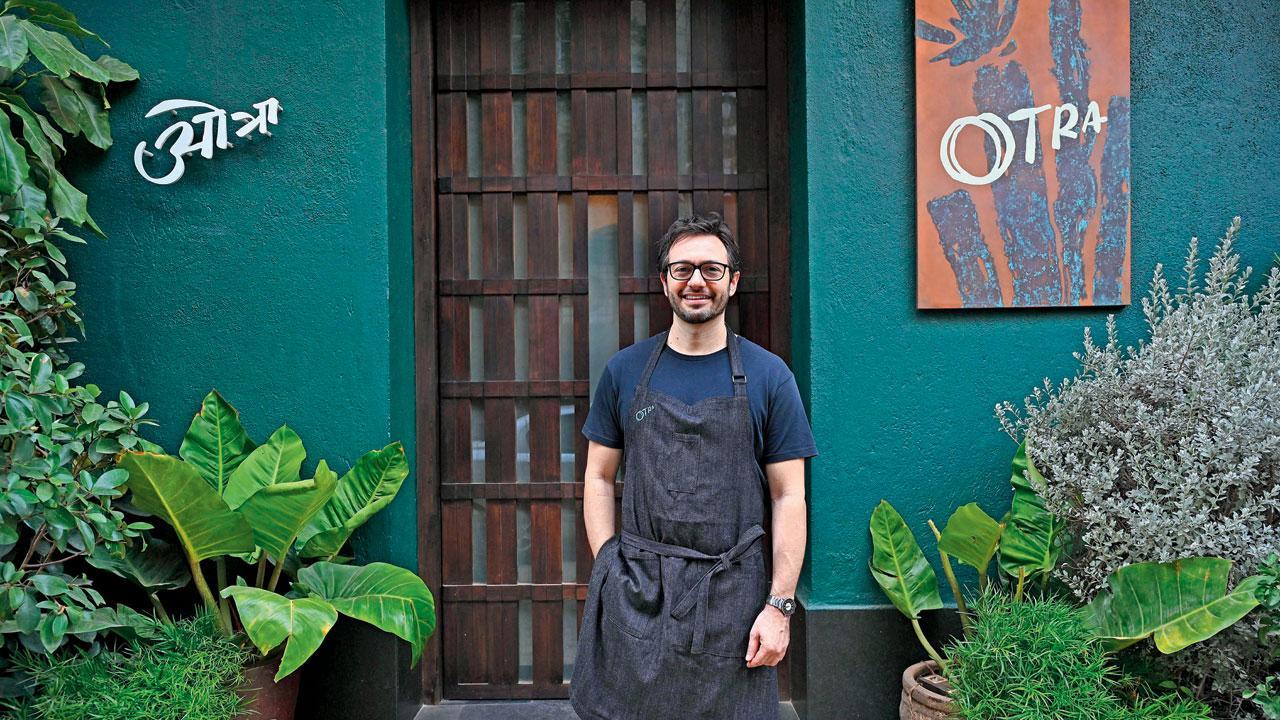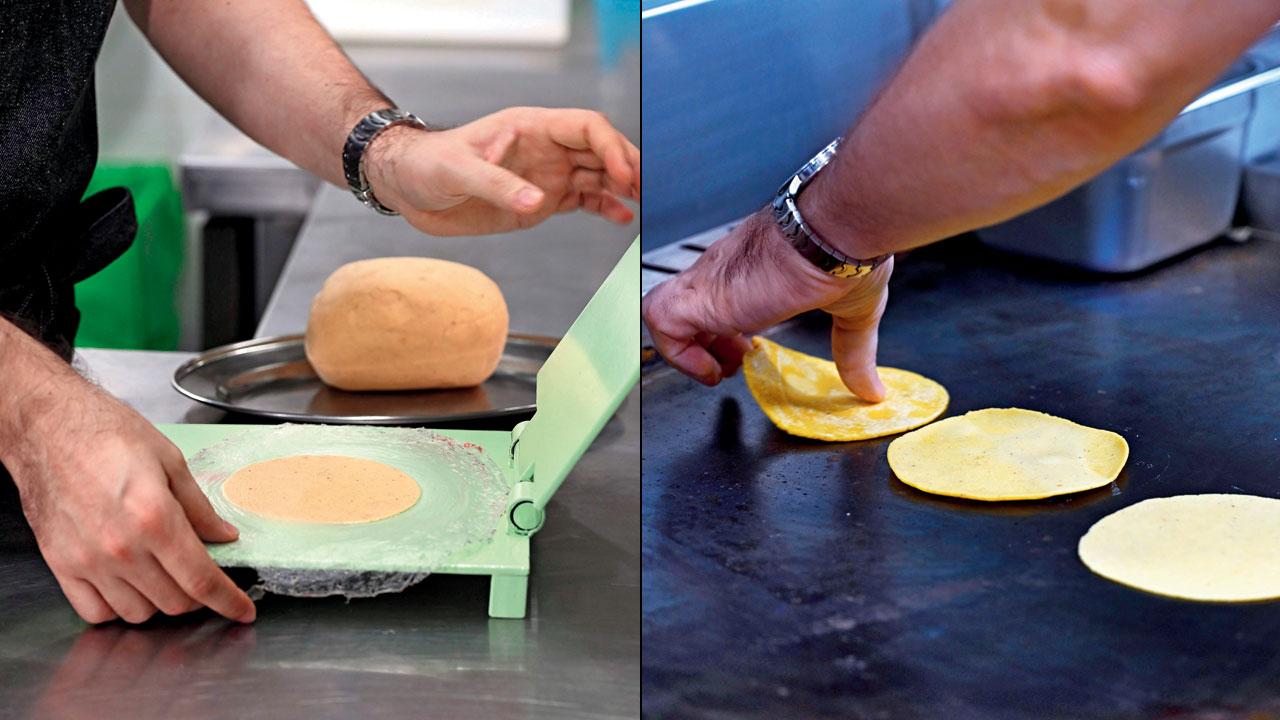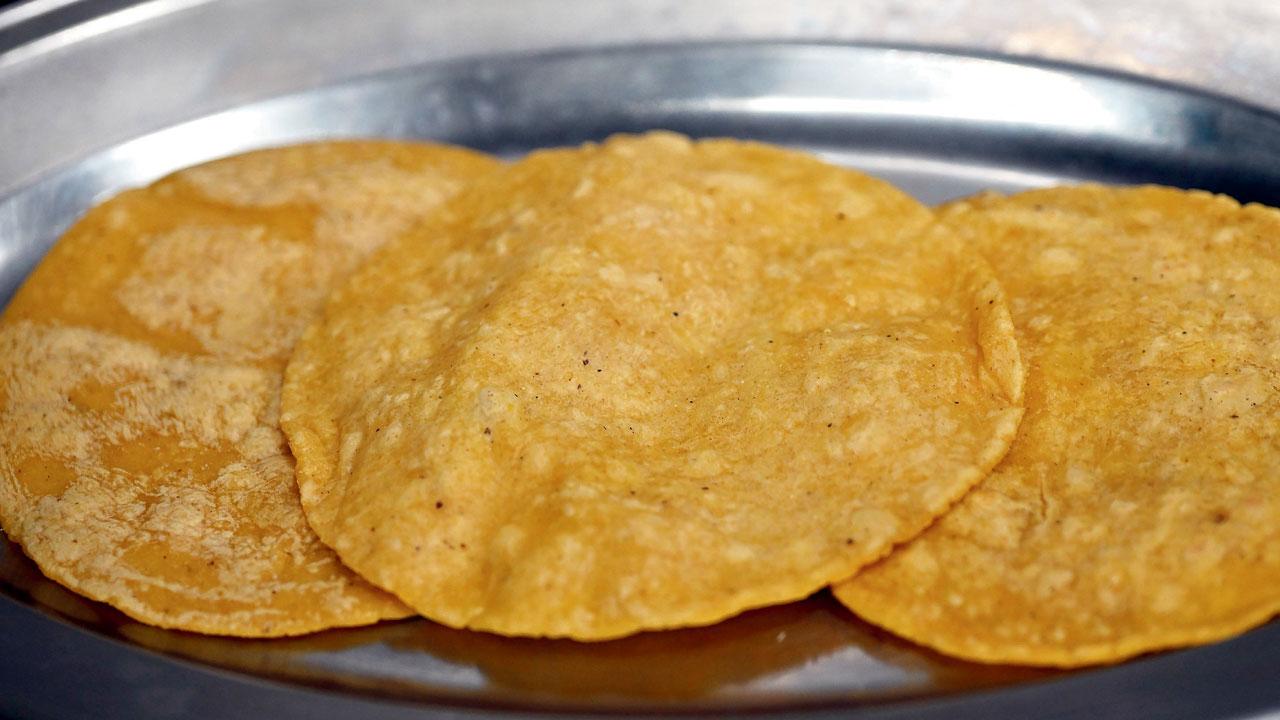A new entrant to offer Latin American cuisine in Kala Ghoda begs us to explore why the cuisine is not all that popular with urban foodies

Chef Sanchez’s Puerto Rican
A short walk from the much celebrated Americano, Chef Alex Sanchez opened doors to Otra, his second restaurant in Mumbai. With its dark, forest-green walls and round bar in Kala Ghoda, Otra pays homage to Sanchez’s Puerto Rican heritage. He says it was the obvious next step for him and his team. “I also have this incredible flavour memory from my childhood of taquerias in San Francisco. I think, to this day, it’s my favourite food to eat. I’m not Mexican, but I know these flavours. They are ingrained in my mind and that’s also something I want to pay homage to” he says.
ADVERTISEMENT

Otra at Kala Ghoda pays homage to Chef Sanchez’s Puerto Rican heritage. It has a corn tortilla on the menu that is made with masa (maise flour) grown in India and ground on custom-made lava stone molino. Pics/Kirti Surve Parade
Sanchez brings forth unique offerings such as masa gnocchi ‘chochoyotes’ dumplings made from masa (a dough made with fresh corn), and they taste nothing like you have ever eaten in the city. But there are also dependable bites like the tostadas and tacos that offer a sense of familiarity. Sanchez says that the tacos on the menu are the closest to what he has grown up eating. The rest is recreated creatively, except the pork belly pernil, a Puerto Rican-style roast pork shoulder. “When I became more acquainted with my dad’s side of the family, this would be made for a big family event, like a Sunday roast,” he says. The pernil at the restaurant is made with pork belly instead of the traditional pork shoulder. Some ingredients in the sauce it is served with have been switched too.

Latin American ingredients and dishes have always existed in India, but the cuisine has only now begun to get heat. We have long been familiar with the Tex-Mex offerings such as nachos, tacos, and burritos at iconic restaurants such as New Yorker and Cream Centre. Even before that, we consumed vegetables that came from Latin America—whether it’s the chillies that spice our food, the tomatoes and potatoes that form the base of everyday Indian meals, or makai rotis without which sarson ka saag feels incomplete.
For centuries, the Portuguese travelled the length and breadth of Latin America and introduced these vegetables to their colonies—India being one of them. In the 15th and 16th centuries, we farmed and adapted these vegetables into our cooking. Besides, many of our cooking techniques in India and Mexico are similar as well.

Niyati Rao and Anushka Neyol
Niyati Rao, Head Chef and Partner, and Mihir Lavande, Sous Chef and Head of R&D at Ekaa, have extensively researched this for the Aztec course on their tasting 5.0 menu which launched in March. The course features a masa tortilla, a chocolate mole (a traditional Mexican sauce) with spices and a lot of complexity, turtle beans with spirulina, a fermented tomato salsa with red ants from Bengal, and a lightly smoked pumpkin (for the vegetarian menu) or slow-cooked pork belly.
As the tasting menu is based on kingdoms of the world, their research led them to discover the similarities in cooking in the Aztec civilization and Indian cooking. “The use of spices the way they [Latin Americans] use in their food to create a complex sauce is something the Indus Valley was also known to do. We can trace that the first spice-mix was used in proto-Indian cuisine from the pottery found in the Indus Valley. Next, they [Latin Americans] use starters for flatbreads; we use wheat, and they use corn. The flavour profiles are very similar as well; we have quite a bit of an overlap of flavours and even some ingredients”, says Lavande, highlighting that ingredients like tomatoes, pumpkin, beans are all ingredients that Indian cuisines use as well. Rao adds, “Indians believe in eating very balanced meals; there’s something fresh, acidic, a carb, protein. I noticed this in Latin American cuisines, too. It’s not something you see in many other Western foods.”

The Aztec course in the Tasting 5.0 Menu at Ekaa had the team extensively research the cuisine and its history
Surprisingly, Latin American food has yet to catch on widely. Perhaps it’s the lack of Latin American migration to India, or our palettes were introduced to those flavours only via American diner-like restaurants. Head chef Pablo Benitez at Mezcalita in Churchgate says, “One reason is the lack of availability of key ingredients [such as tomatillos, nopal, jicama, etc] central to Mexican cuisine.” Could this be why restaurants stick to tacos, tostadas, and burritos? Benitez adds, “These basics are more familiar and easier to market because they are already popularised globally. Mole and other traditional sauces require a deep understanding of the complex ingredients and techniques. Additionally, the flavour profiles of mole include ingredients such as chocolate and various chillies, which might be unfamiliar and challenging for new patrons to appreciate immediately.”
Otra developed a homegrown solution to tackle the need for more ingredients and avoid high import duties. The restaurant wanted to make its own masa for tortillas, tostadas, and more. “The tradition of making corn tortillas from masa goes back to Mesoamerica. The more that I looked into it, the more curious I became. It’s this amazing culinary process and a bit of chemistry,” says Sanchez.

Pablo Benitez, executive chef at Mezcalita, makes his favourite recipe, esquites or corn soup from Mexico. PIC/SAMEER MARKANDE
“Chef Alex told me, ‘If you can grow corn, I’ll open a restaurant’,” says Anushka Neyol, founder of Three One Farms in Punjab, a seventh-generation farmer. “Ninety-nine per cent of the corn grown in India is hard and used to feed poultry, or processed industrially to make flour, starch and so on,” she says. Tortillas need a medium to soft variety of corn, which took several tries to find. Neyol worked closely with Punjab Agricultural University in Ludhiana to find varieties Otra could use for its in-house masa. She says it took over 50 varieties to find the one—an indigenous heirloom yellow corn that is around eight years old in India and has a buttery flavour. Neyol found this at the university, which maintains over 100 varieties of corn. At her farm, she is now growing more varieties that will be used at Otra. The harvest is expected in June, giving the restaurant a few colourful varieties of crop to work with.
The restaurant is working with other farms to grow more ingredients that are key to the cuisine. This includes aji amarillo chillies, oregano, and cilantro varieties. But would growing crops that are not native to India work? “You either grow in small portions or not at all. The seed takes almost five to seven years to evolve,” says Sneh Yadav, founder of Tijara Organic Farms in Rajasthan. “We once tried to grow jalapenos in small quantities, but the crop did not survive.” Yadav found a different variety of heirloom chilli, which has a similar texture and flavour to a jalapeno, except it’s a little hotter. As heirloom crops have long adapted to the soil and become part of the ecosystem, they yield better produce. Yadav says corn has adapted well to India. “It’s part of the Indian diet in many states. In Madhya Pradesh, they eat red corn porridge dalia.”

Mihir Lavande and Hanoze Shroff
At Otra, once Neyol sent over the corn, chefs got to work. They broke the corn and ground it by hand until the custom-made lava stone molino arrived from Los Angeles and the masa of their dreams was finally produced to make airy, aromatic tortillas. “The challenge that we presented ourselves was to show India, a country that has arguably some of the best flatbreads in the world, that this has value,” says Sanchez who might have begun growing vegetables once only native to Latin America, but there’s still a lot they import.
Whether that’s Mexico’s agave spirits such as tequila and mezcal, or even Nikkei, the Japanese-Peruvian cuisines, restaurants in India are pushing the bar to bring forth Latin American offerings. “There has been a growing global interest in exploring diverse cuisines and experiencing authentic flavours of different regions. Mexican cuisine naturally fits this trend with its rich tapestry of ingredients, history, and vibrant flavours. The rise of well-travelled and culturally curious diners has created a demand for genuine Mexican fare,” says Rizwan Amlani, partner at Mezcalita.

Rizwan Amlani, Partner, Mezcalita
The question remains: Are we doing justice to the 33 Latin American countries and their unique cuisines? Chef Hanoze Shroff of Juju, a tequila bar in Pune, says, “Our menu is a blend of inspiration and authenticity. While most dishes are inspired by traditional Latin American cuisine, we do have a few that we prepare authentically. For instance, our lamb birria taco. This balance allows us to introduce new flavours while respecting culinary traditions.” Shroff says that patrons are hungry for more. “This openness makes it a joy to introduce Latin American cuisine to the local palate,” he adds.
 Subscribe today by clicking the link and stay updated with the latest news!" Click here!
Subscribe today by clicking the link and stay updated with the latest news!" Click here!







